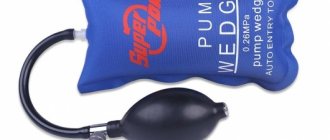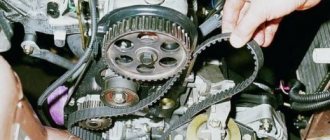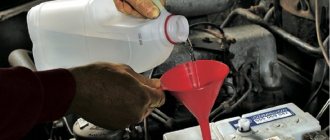Russia is the undisputed leader in cold weather among all countries in the world. It is in our country that the coldest place on the planet is located, and the problem of a car freezing in severe frosts is more relevant here than anywhere else. Almost every car enthusiast in our country has encountered it, and knows what an unpleasant surprise it is, especially in the morning when you are rushing to work. A frozen car can cause a lot of trouble and ruin all the plans of its owner. Let's figure out what to do if the car won't start in the cold and how to deal with it.
Melt with hot water
When defrosting doors with hot water, it is important to consider that it will subsequently cool down and freeze. But if you urgently need to open the car at this very moment, then pour hot water on the frozen areas, tapping on the door in this place. It will quickly melt the ice on the surface and you will open the door. You can apply a bottle of warm water to small areas of freezing, but in severe frost this is ineffective.
Surely every motorist has experienced a lot of unpleasant sensations when the doors of his car froze in winter.
The culprit is moisture that gets on the surface of the seals - it can settle on them in the form of condensation or flow inside. As a result, these rubber bands connect the door to the body, which becomes the reason for such an unpleasant restriction of access.
Knowing the best way to lubricate the seals if your car doors freeze, you will be able to survive the next winter season without such troubles.
So what should you do if the lock on your car door is frozen?
In the case when the car has a security alarm, sometimes it is possible to open a frozen lock using the alarm key fob, but in this case this does not always work, since in the cold the battery in the alarm key fob quickly runs out and this key fob becomes simply useless.
But then how to open a frozen lock in a car - only with the help of the car door key. First of all, you need to check that every door of your car can be opened, including through the trunk in hatchbacks or SUVs.
If you still can’t open it, then how to quickly open a frozen car lock, and most importantly, without any damage to the lock itself. In this case, there are three methods that have been proven over the years:
- First, we try to crumble the ice that has formed inside the car door lock, to do this we slowly begin to rotate the key inside the lock from one side to the other, the main thing here is to act very carefully and carefully so as not to overdo it, and as a result, not to break the key itself inside the lock, and Such procedures should be performed with each door in the car, most importantly carefully;
- Another method is heating, it is suitable in the case when the key inserted into the door lock simply cannot be turned in one direction or the other, to do this we try to melt the ice that has formed inside the lock - the easiest option here is to slightly warm the key itself with a lighter , you can, of course, initially insert a thin wire into the lock itself and heat it, or warm up the lock using a heated cigarette lighter if there is another open car nearby;
- the central lock in the car is frozen, how to open it - we try to defrost it, although this will require a special kind of defrosting spray, we simply spray such a can inside the lock itself and wait a little, the alcohol compounds included in such a spray will be able to melt the ice inside the lock, among other things, in this way , possible corrosion inside the lock is prevented, or you can use regular alcohol and inject it inside the lock using a medical syringe, the result is the same.
It should be noted that sometimes you can find harmful advice in this case, which in no case should be used:
- You should not try to pour hot water into the car door lock, as this can only worsen the situation;
- among other things, you should under no circumstances try to blow into the lock, thus only increasing the amount of condensation inside the lock and thereby worsening the situation;
- You should also not try to spray liquids based on kerosene inside the lock, because they are not able to melt the ice, although they can remove the internal lubricant in the door lock.
Option #1
To prevent the rubber seals from becoming the reason for the inability to get inside the car, you need to lubricate them with a special hydrocarbon composition, which is designed to preserve individual components of cars. The best option available on the Russian market is polymer silicone grease, which tolerates low temperatures well even during the harshest winter. However, if it is not within reach, you can treat the car doors with technical Vaseline, although the duration of the effect in this case will be slightly shorter.
The best option is lubricant packaged in - it allows you to complete all the necessary procedures in a matter of seconds. Liqui Moly, XADO, Forsters and other manufacturers offer their options for quickly saving a car from freezing. However, a paste-like composition can also be applied to the rubber seals, which is sold in small tubes - most often this is how Russian-made PMS-200 lubricant is packaged.
The main advantage that silicone grease has is the ability to work in the temperature range of -50...+250 degrees. In addition, it forms a fairly stable polymer film on the surface of the door seals, which retains its properties for 2-3 weeks, which allows you to get rid of the freezing problem for a long time. It is very easy to apply, especially if we are talking about a specialized lubricant for cars supplied in the form of a spray. However, before using it, it is better to wipe the rubber bands dry to prevent the formation of small drops that, if frozen, could damage the seals.
How to avoid freezing of car systems
The main rule is to properly prepare the car for cold weather .
First - battery
To ensure that the battery does not let you down, look for deposits on the terminals; if there are any, remove them. Measure the battery voltage ; if the voltage drops, it is best to replace the battery with a new one. You should also check the distillate level. If the battery life is approaching its limit, you should still take care of buying a new one.
Dangerous but effective
If you don’t have hydrocarbon lubricant on hand, in winter you can protect your doors from freezing using a well-known compound called WD-40. Experts recommend always carrying it in your car in order to be able to defrost certain moving joints, as well as clean moisture from parts that are more susceptible to corrosion than others. If your door seals freeze, just apply a thin layer of WD-40 to them to forget about this problem for several days.
The lubricant comes in the form of a spray, so there will be no problems using it. Interestingly, each jar is equipped with a thin tube, which allows you to work in hard-to-reach places, so the composition can be easily applied under the seal from the outside, where moisture also often accumulates. However, you should be very careful as WD-40 can cause serious damage to the rubber and plastic components used in the car. Therefore, it should only be used as a means of emergency rescue, and as soon as possible, go to the store to buy silicone-based lubricant.
Got wound up
How to properly defrost a car in winter
After the engine is started, you need to give it time to warm up. You shouldn’t turn on the stove right away; it’s better to clear the snow from the hood at this time and check the wiper blades for ice. There is no need to touch the roof in severe frost, just brush away large snowdrifts. It will melt on its own, and you can save money on windshield washer. And don’t rush to panic if the window doesn’t go down, the mirror doesn’t respond to adjustments, wait until the interior warms up, everything will come unstuck on its own. The same applies to the gearbox; when the oil in it warms up, the gearbox will work as it should.
Alternatives
To prevent car doors from freezing, you can use special water-repellent compounds that do not contain hazardous components. This lubricant is produced by several companies - for example, TurtleWax, Wynn's and others. It contains a small amount of technical silicone, as well as polyesters and other organic components, which are included in the composition to create a durable film on the surface of the seal that retains its elasticity for a long time. Applying the composition to car door rubber bands is very simple, since it comes in the form of a spray.
There are also exotic products that also help combat door freezing. For example, in the Far North and other cold regions, bear or deer fat is used to prevent restriction of access to
Such products effectively cope with freezing, but are rarely found on sale and allow you to get the effect for only 1-2 days.
Emergency measures
If the car doors are frozen, you should never try to tear them off by force or use an oblong object as a lever. To open them, first try to shake them, rocking them in and out within the limits of free play - in most cases this helps to cope with the situation without damaging the seals. Alternatively, you can try entering through other doors or through the trunk if your car is a hatchback or station wagon. However, after washing, access to the car can be completely blocked, since water gets under the seals of all doors at the same time.
As a last resort, you can pour warm water over the door cracks.
If all else fails, fill a two-liter bottle with warm (but not hot!) water, and then begin to slowly pour it into the gap between the door and the body, being careful not to wet the seat. After pouring out about a fifth of the bottle, try shaking the door again and check if the seal is coming off. When the door is open and you gain access to the interior of the car, immediately start the engine and turn on the heater to get rid of ice on the seals. When the car thaws, immediately take paper napkins and thoroughly wipe all the rubber bands on the car doors. In addition, it would be advisable to lubricate them before the next long stay, so as not to encounter such an unpleasant problem.
What should you do if your car doors freeze after washing or after heavy rain, when water gets into the seal or lock? How to open a car without damaging the rubber bands and without consequences for the cylinder mechanism? Ten ways to defrost doors, locks, and trunk.
In Russia, this situation happens all the time due to low temperatures - water gets into the lock or between the doors themselves after washing, rain, or snowfall. Incorrect actions lead to the rubber seals deteriorating and the lock to fail.
Also, quite often the central locking fails, the latch itself freezes, the doors or trunk cannot be opened, but it is very necessary.
Method number 1: lock defroster
The most commonplace way is to buy a special lock defroster in a can. There are a lot of products from Good Year, Liqui Moly, Felix, Russian “Valv”, “Eltrans”, “Avtolider”. They are usually made with methanol or ethylene glycol, sometimes containing silicone or acetone.
Simply inject the product into the frozen lock and spray along the contour of the door, trying to reach the frozen ice. This must be done extremely carefully, have a napkin on hand, and try to ensure that the composition (especially with acetone) does not get on the paint.
Method number 2: alcohol
The most normal way, relatively safe. A bottle of regular alcohol, you can take a rubber bulb (enema) for more convenient use. It is poured into the lock and door cracks (the seal can be lifted with a thin plate, for example, with the back of a knife), wait a couple of minutes, and the door opens.
Instead of alcohol, you can use antifreeze fluid from the washer reservoir. But pure alcohol is better - its excess evaporates without causing any particular harm to the locks and elastic bands. The only disadvantage of this method is that the cabin stinks of alcohol, so traffic cops may find fault.
Method number 3: nail, plate and lighter
You can defrost individual sections of a frozen door with a thin long nail, a plate and a lighter. You can use a torch instead of a lighter. But you can remove the ice from the lock itself by heating the tip of the key with a lighter.
The plate is inserted into the gap between the doors, the free end is heated. Through thermal conduction, the ice begins to thaw. Or you can slightly heat the tip of the plate itself. It is important to do everything carefully so as not to spoil the paintwork or melt the rubber bands.
Method number 4: warm WD-40
If the doors are frozen after washing, many drivers keep a warm can of WD-40 at home. By generously watering the area of icing with a “wedeshka”, you can achieve fairly rapid thawing.
When cold, WD-40 is almost useless; you can keep the bottle under your clothes to warm it up properly.
Method number 5: warm water
The stupidest way, but for some reason very beloved by the owners. If you splash warm water on a lock or door, the effect is almost instantaneous, but, as you can understand, the water instantly freezes again, aggravating the situation.
And if the frost is -40, then it’s better to immediately pour cold water on it, at least the paint will remain intact. By the way, if water gets on cold glass, it is highly likely to crack.
Method number 6: heating pad, rope, blanket, brick
A safe way, but rather perverted. A hot water bottle is tied with a rope to a brick (or two). The brick is placed on the roof, the heating pad is hung in the right place, near the frozen door or lock. The whole thing is covered with a blanket and taped around the perimeter with masking tape.
10-15 minutes in such a “bath”, and any door thaws. The main thing is to avoid heat leaks, choose a warmer blanket, and take hot enough water.
Method number 7: hair dryer
The most normal and safest way, but you need an outlet. You can defrost doors with a regular hair dryer; a heat gun, wind blower, or any directional heater are also great.
Instead of an outlet, some use an uninterruptible power supply or a converter from a car battery. True, you won’t be able to warm it up for a long time if you use batteries. But a hairdryer can thaw even frozen latches, actuators (closers, crossbars) of central locks, and so on.
Method No. 8: exhaust gases
Another way to open a door that is frozen after washing is to drive another car and direct the exhaust flow. The main thing is that the other car is well warmed up and adjusted.
The method cannot be used in closed areas; you must remember that you can get sick from exhaust gases. Some people put a piece of hose on the exhaust pipe to make it easier to direct the warm flow.
Method number 9: mechanical
Mechanically, you can quite successfully remove ice from rubber and seals if the doors are frozen solid. To do this, you will need a thin plate - from windshield wipers, a metal ruler, a piece of blade from a hacksaw (the teeth just need to be ground off), a valve gauge, a strip of tin, and so on. Sometimes table knives help.
The main thing is not to damage the seal. At the same time, it is worth remembering that if the latch itself is frozen, then nothing can be done about it. Sometimes a frozen lock cylinder can also be picked out with a thin knitting needle.
Method number 10: dark fabric
In spring and early autumn, if the car is parked in the sun, you can speed up the defrosting of the doors by covering them with dark fabric or black agrofibre.
Sometimes this helps even in winter. In the field conditions of a village, you can generally close the doors with felt or tarpaulin and make a fire nearby. The heat from the fire can be directed to the car by constructing a screen from cardboard.
After using lock defrosters, WD-40, anti-freeze washer fluid and other products, the lock needs to be lubricated. Either with silicone grease or motor oil using a syringe with a needle.
To prevent the seals from freezing, it is better to wipe them with a napkin after washing. You can also use silicone lubricants in small quantities or rubber care products.
By the way, if the car is a car, then the rubber bands do not freeze due to the fact that the ice does not stick to them.
Alternatively, to prevent the door from freezing, you can wrap it around the contour with toilet paper. Even if the seal allows water from rain or melted snow to pass through, when opened, the paper will tear and the door can be opened easily.
To break the ice structure, the door must be pulled in two directions. At the same time, use sharp pushes to press against the body. Usually such a simple movement gives a good effect.
Sometimes, if the car doors are frozen after washing, nothing can be done, because the ice has frozen somewhere in a deep place, which is not even warmed by an external source - then you can only wait for spring.
Editor's response
A frozen car turns into a collection of fragile parts. When trying to get inside, the handles can be torn off or the rubber seals can be torn. Is there a way to carefully rid him of the ice captivity?
In the off-season, temperatures often fluctuate around zero and at night favorable conditions arise for the formation of ice. The fallen wet snow covers the car with a wet snowdrift, which first melts and then turns into an ice shell. In the morning it becomes difficult to open the doors without harming the car. What to do in this situation?
Warming up the car. How to revive a frozen car?
If the door is still frozen, do not overdo it in trying to open it. In the cold, it’s easy to break off a door handle, leaving it in your hands in front of a door that never gave up. Instead of forceful methods, use ingenuity: check other car doors - perhaps one of them will open easier. You can gently tap the perimeter of the door with your palm to crush the ice inside the opening. And the most elegant, albeit time-consuming way to get into the car is to start the engine remotely and wait until the heater warms up the interior, releasing the doors.
Cleaning windows and wipers from ice
Can you scratch glass with a plastic scraper? From a physics point of view, this is impossible: plastic is much softer. However, scratches that sometimes appear on the glass even from the operation of rubber wipers raise doubts about scientific calculations.
In fact, it is not wipers or scrapers that scratch the glass, but small grains of sand and solid particles of dirt that end up on the surface. Ice crystals are softer and cannot damage the glass, but you should still be careful when working with a scraper: clean off frost and ice in one direction, without chaotic movements in different directions.
“Lazy” melting of ice on glass with a stream of hot air from the stove is fraught with a more serious problem than scratches. Due to the temperature difference, there is a high chance that the glass will simply burst, and an impressive crack will appear before the driver’s eyes. This often happens when there are small chips on the glass.
A glass defroster will help you safely and quickly clear ice from your glass. Thin ice and hoarfrost after treatment are easily removed with a wave of the wipers, and a thick layer of ice that has frozen over several days softens and is scraped off with almost no pressure.
Windshield wiper blades should also be treated with a defroster, since mechanical cleaning with a scraper can damage the rubber bands. And turning on wipers that are frozen to the glass is fraught with damage to the electric drive.
How to revive a dead battery
Can the battery freeze in the cold? Fully charged - no, the electrolyte in it remains fluid down to -60°C and even lower. But on short city trips, the battery is rarely charged 100%, and electrical appliances running in the background (alarm, immobilizer, keyless entry unit) gradually “eat up” the charge. And this is already dangerous: in a half-discharged battery, the electrolyte turns into ice at just -20°C.
| Physical properties of the electrolyte | |||
| Electrolyte density, g/cm3 | Voltage at current terminals | Battery charge level | Freezing point |
| 1,27–1,29 | 12.6–12.7 V | 90–100% | -60°C |
| 1,23–1,24 | 12.4–12.5 V | 70–80% | -40°C |
| 1,18–1,22 | 12.2–12.3 V | 40–50% | -20°C |
| 1,09–1,13 | 11.7–11.9 V | 0–10% | -10°C |
Frozen electrolyte damages the plates, and the battery cannot be saved, so you need to carefully monitor it, avoiding deep discharge. Before parking for a long time in the cold, check the battery voltage (recharge if necessary) and remove the terminals from the current leads to prevent leakage.
But a completely discharged and frozen battery is an extreme case, which is best not allowed to happen. Usually it all starts with unsuccessful starting attempts and uncertain rotation of the starter. This battery needs help, the best thing is to dismantle it and charge it with a stationary charger at home. Temperature affects the speed of the chemical reaction, so don’t rush to charge a battery just brought in from the cold - let it warm up for a couple of hours.
For quick assistance on the street, you can use a charger and starter as an additional power source, or resort to a classic “light” from another car - for this you will need high-quality jumper wires.
How to start a frozen engine
So, the battery is in order - charge it, “light it” or buy a new one. How to start a car in the cold? Successful engine starting in cold weather depends on several factors:
- Battery starting current
- Suitable oil viscosity
- Serviceability of spark plugs/glow plugs
- Availability of fuel and its flammability
- Correct mixture formation in the cylinders
If the starter turns confidently, but the engine does not start, something is wrong with the last items on the list. When trying to start for a long time, the spark plugs are often flooded with gasoline and they do not produce a spark. Drying spark plugs does not always help - it is better to immediately replace them with new ones. A diesel engine does not need a spark, but it does require a high starting temperature in the cylinders - make sure that the glow plugs are working properly.
What kind of gasoline is better to fill in in winter? The higher the octane number, the higher the detonation resistance of the fuel (important for forced engines), but it also complicates winter starting. 95 gasoline is more difficult to ignite than 92 gasoline, and 98 burns even worse. Therefore, in winter it is better to refuel with gasoline with the minimum octane number allowed for your engine.
What about diesel? According to regulations, winter diesel fuel should not freeze to -35°C (summer diesel fuel crystallizes at -5°C), but in practice, the formation of paraffins in winter fuel can be encountered already at -25°C. For prevention, it is better to pour anti-gel for diesel fuel into the tank on the eve of a cold snap. If the fuel is already frozen, then reviving the car will not be easy. Yes, there are special defrosting anti-gels, but they can only restore the fluidity of the fuel in the tank. To start the engine, you will have to manually bleed the line and replace the fuel filter.
To start the engine, it is not enough to supply air and fuel to the cylinders; you need to do this in the correct proportion, which depends on the correct operation of the sensors. But they often malfunction in the cold, making the mixture too lean or too rich. In this situation, you can manually create the air/fuel mixture using quick start fluid. It is injected directly into the intake pipe and enters the cylinders, where it ignites easily and the engine starts successfully.
If no tricks help, and the engine does not start, there is no need to torment the equipment, which already has a hard time in the cold. You will have to radically change the starting conditions: heat the engine compartment with a heat gun, evacuate the car to a warm box, or wait for warmer weather.
Source
Spare hole
Most often, rubber gaskets freeze on car parts, as well as windshield wiper blades and even locks. If you start pulling the handles with force, you can do a lot of damage. In the worst case, the soft rubber that tightly fits the door joints will break. The tightness of the seal will be broken, and water will begin to enter through the hole, which will lead to even greater damage to the rubber and even the appearance of rust. In addition, if too much force is applied, the plastic handle on the door breaks. In the cold it becomes fragile.
But even if you pull the handle carefully, it’s easy to get into an unpleasant situation. The door lock unlocks, but the door does not open. And to re-lock the lock, you need to slam the door or press on it. But it’s frozen and won’t budge, and a frozen lock doesn’t always work adequately. As a result, the security system begins to go crazy and issues warnings. You won't leave the car anymore. What to do in this situation?
If you have a hatchback or crossover, consider yourself lucky. Their back door never freezes because the seals and lock are covered with metal edges. We open the lid, clear out the things in the trunk, fold down the backs of the rear seats and make our way into the cabin on our knees. There you can take off your shoes so that your sharp heels don’t tear the seat upholstery, and we climb into the driver’s seat. Next, turn on the engine with the heater and warm up the car.
If necessary, you can slam the rear tailgate from the inside and hit the road. As you drive, the car will heat up and defrost the frozen seals even faster than in the parking lot. After half an hour, the doors will open without problems.
Professional advice on how to start a car in cold weather
Let's look at the most common problems with starting a car engine in cold weather.
Problem one: The starter does not turn the engine or its operation is unstable. If this problem occurs:
- Turn on the low beam headlights for 10-20 seconds. This way we will wake up the battery, and the next time we try to start it, it will give more voltage.
- Inspect the terminals on the batteries. If they become dirty or oxidized, they must be cleaned to improve contact.
- If your car has a manual transmission, you can try to push start the car.
- Remove the battery and take it to a warm room to warm it up.
- You can “light up” from another car.
- Replace the battery with a new one.
If none of these methods help, then the problem lies in the starter and will need to be repaired or replaced.
Problem two: The car has a good starter and battery, but the engine cranks with great effort, and thickened oil is visible on the dipstick. To solve this problem, you need to put the car in a warm room or wait for warm weather. Provided that the car has a manual transmission, you can try towing it to stir the oil. A prompt oil change is not possible in this situation.
Problem three: All systems work properly, the starter turns the shaft, but the car still does not start. In this case, it is necessary, first of all, to check the spark plugs for splashing with gasoline. If this is the case, they need to be cleaned, calcined or completely replaced. This problem can also occur due to low-quality fuel. It may contain large amounts of water. To combat this problem, there are special fuel “driers”.
If none of these methods help, then the problem is most likely more serious. This could be a malfunction of the fuel system, ignition system, etc. Starting a car in cold weather should be done according to the following scheme:
- The first step is to turn off all electrical consumers (headlights, heated seats and windows, stove, etc.).
- Next, you need to turn on the ignition and wait 10 seconds.
- Turn on the low beam headlights for 10-20 seconds to “wake up” the battery.
- We try to start the car with the clutch depressed, the starter operation should not exceed 10 seconds, if the car does not start, you should wait 1-2 minutes. After this, we repeat the attempt to start the engine.
- If one-time flashes occur, but the car still does not start, you should depress the gas pedal. And try to start the car.
Alcoholization of ice
If you have a sedan, you will have to work hard, because it does not have a spare hole. The door joints will need to be cleared of ice. In no case should you use sharp objects or improvised means for this, for example, a plastic ruler or pieces of branches broken off from a bush. They can tear the rubber seals or even scratch the paint.
It is best to buy a bottle of vodka and pour a little into a plastic shampoo bottle with a long spout. This device will help inject a stream of alcohol liquid under pressure directly under the seals. Warm alcohol warms the ice and is able to dissolve water in itself. In addition, it does not freeze later.
Then you can gently pull the door, and if the ice still holds, you need to repeat the procedure until it is completely defrosted. The main thing is to get into the driver's seat. Next, turn on the engine and heat the car with the stove. In this case, it is better not to activate the maximum window blowing mode immediately. It is necessary to allow the car to warm up gradually at medium fan speed so that sudden temperature expansions do not damage the windshield.
Well, in the future, in order to avoid possible freezing, you can wipe the rubber door seals with silicone grease or a special chemical composition that prevents the penetration of water. They can be purchased at any auto parts store. For example, a product for protecting locks and hinges from freezing costs from 50 rubles. and is already placed in a spray bottle. A bottle of anti-freezing agent for rubber door and trunk seals costs about 150 rubles. and also has a long nose. And universal frost-resistant silicone grease is available from 100 rubles and is sold in small tubes.
How to wash the engine in winter
It is well known that keeping the engine compartment clean allows you to avoid overheating of the power unit as a result of the accumulation of thick layers of dirt, making it much more convenient to maintain or repair a clean engine. In case of emergency malfunctions (for example, oil leakage), after eliminating the source of the problem, the engine must also be washed.
Let us add that in cold weather oil leaks through oil seals and gaskets are noticeably more likely, there is a high probability of leakage of technical fluids through connections using clamps, cracking of pipes appears, etc. The individual rubber parts under the hood will last longer if they are kept clean. Taking into account the above, many drivers regularly wash their engine in the summer, while adhering to the basic recommendations and rules.
However, in winter, most car owners prefer not to wash the engine at all and try to wash the car body less often. The reason is paint protection, the desire to minimize the amount of moisture under the hood and avoid problems with electrical equipment during engine startup. Many people believe that in winter it is much more difficult to dry the engine after washing. Let us immediately note that there are no fundamental differences between engine washing in summer and winter. The only thing is that it is simply impossible to wash the unit outside in cold weather with your own hands. Washing your engine yourself in winter requires having a warm box or garage. Also, the issue of drying should be given increased attention. It turns out that if there is a need to wash the engine in winter, then it is better to contact a car wash or specialized services that provide this service.
General rules when washing an engine in winter:
- remove the terminals from the battery;
- reliably protect electrical equipment from water ingress;
- apply a special chemical solution to remove contaminants;
- wash off the applied cleaner with a stream of water under low pressure;
You can also use the steam engine cleaning service. This washing method is more popular compared to conventional Karcher washing, since less moisture gets into the engine compartment, and the cleaning result is better.
We also recommend reading the article about what steam engine washing is. From this article you will learn about the distinctive features, advantages and disadvantages of this method compared to traditional methods.
In parallel, during the winter washing of the engine after drying, you can additionally apply anti-corrosion compounds to those areas where the appearance of pockets of corrosion is noticeable, as well as for preventive purposes to undamaged areas.











